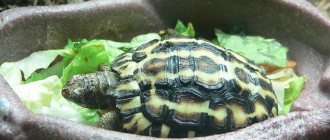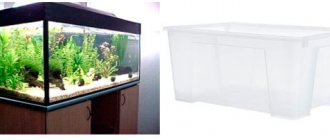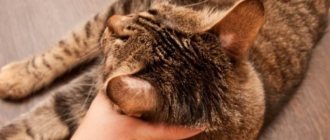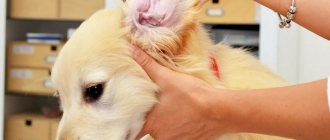Pneumonia (pneumonia):
Symptom.
The turtle is lethargic and does not eat well. Most often, the turtle floats on the surface and does not drown; it tries to dive but nothing works. Treatment. The disease is most often the result of hypothermia in the turtle. When our turtle got sick, I searched the entire Internet and found 2 methods of treatment. 1 medication (intramuscular injections)
I don’t know why, but the result of such self-treatment (in many reviews) was the death of the turtle, so you need to use it strictly following the doctor’s recommendation! Attention: When calculating the injection volume, keep in mind that the weight of the turtle must be divided by 2 because the shell does not count! 2 folk (successfully used by me personally)
A decoction of chamomile is prepared. Take the turtle and hold it over the steam of the prepared (heated) broth for 3-5 minutes. The turtle should not be burned, i.e. your hand should not be hot. After this, part of the broth is diluted in warm water, about a 3-liter glass (the water should be 28-30 degrees). The turtle is placed in this solution and remains there for 30 minutes to an hour. After this, we place the red-eared turtle home, having previously raised the water temperature in the polydarium (aquaterrarium) degrees to 28-29. If necessary, repeat the procedure every other day. Experience from a visitor to the TA2U website: “At the beginning of March, I bought a turtle at the market, a very tiny one, weighing approximately 8 grams. And I got her, it turns out, with pneumonia, because on the third day of her stay at my house she stopped eating, began to swim on her right side, could not dive, spent most of her time on the island, and was constantly gasping for air. the condition worsened every day. The veterinarian shrugged their shoulders. Then I looked on the Internet and took the risk of curing it myself. I took injections of Baytril 2.5%. Calculation: 4 mg per 1 kg of body weight (the shell does not count). For my turtle, 8 grams - in an insulin syringe divided by 100, the antibiotic was divided into 2 divisions. I pricked the right front paw 5 times every 1 day. And I also kept the turtle in a strainer over chamomile steam for 3 minutes, once a day. Then I placed it in a saucepan with water with the addition of chamomile decoction, 1 tbsp per glass of water. l. decoction (water in a saucepan 30 degrees) for 30-40 minutes. The water in the aquarium is at least 28-30 g. On day 5 I started to get better! Good luck!"
Caring for a red-eared turtle at home
During treatment, it is advisable to maintain a normal water temperature in the aquarium, not lower than 23 degrees. It is also desirable that the animal spend more time on land. With proper treatment, the formation will begin to noticeably decrease after 2 weeks, and will completely resolve after about 2 months.
When a purulent focus breaks out on its own into the upper jaw, the wounds need to be treated with Terramycin for 3 days, and then (if there is no pus left and the wound begins to heal) with Methyluracil, Solcoseryl or Eplan to speed up healing. After the procedure, the turtle must remain on land for at least an hour. It is also advisable to inject Baytril 2.5% for a week. Antibiotic dose – 0.2 ml/kg.
To reduce the likelihood of otitis media, monitor the condition of the water surface; there should be no film there. It is here that pathogenic organisms multiply and can cause inflammation.
Hearing diseases
The most common disease affecting the auditory organs is otitis media. The severity of otitis is that the disease goes unnoticed for a long time, as it often develops asymptomatically, and subsequently leads to serious problems.
You can identify the presence of otitis media in a pet by the following signs:
- The turtle's cheek is swollen and asymmetry is noticeable.
- The pet becomes apathetic and turns away from food.
- The turtle's coordination of movements is impaired.
Otitis in reptiles can be unilateral or bilateral, when swelling is observed on one side, or both cheeks of the turtle are swollen. With the development of otitis, veterinarians assume the following consequences:
- The release of pus through the skin.
- Exit of purulent discharge through the mouth.
- The need for surgical intervention.
If the pus comes out through the skin, the resulting wound is treated with disinfectants. If no breakthrough is observed, the area where pus accumulates is massaged, stimulating exit through the mouth. If attempts fail, surgery is required. After removing the pus, the animal is provided with good nutrition, vitamin complexes and the administration of calcium gluconate.
Treatment of otitis media in red-eared turtles
Since the formation contains pus, which does not resolve on its own if it is in a closed cavity, surgical intervention is often required. It is better if it is carried out by a herpetologist, but you can also contact a general veterinarian. After opening the abscess and washing the cavity, you will need to apply Levomekol ointment to the wound, as well as carry out antibacterial therapy. If there is no specialist willing to perform surgery on the reptile, you can treat it conservatively:
- Inject Baytril for 10-14 days.
- Give vitamins (Eleovit or analogues).
- If the animal refuses to eat, administer Ringer's solution in small quantities, adding glucose and ascorbic acid to it in the volumes prescribed by the doctor. The dosage of the composition is no more than 1% of the turtle’s weight at a time.
Symptoms
The causes of each type of disease are different, the main problems are as follows:
- contact with an infected animal or placement in a dirty place;
- injuries of varying severity;
- stress during transportation, transfer, changing climatic conditions;
- poor nutrition, resulting in a lack of vitamins;
- incorrect water temperature or severe contamination.
Red-eared sliders do not move much, so identifying the symptom at first glance seems difficult. You should be wary if the following signs of illness are detected:
- the animal lingers on the surface of the water for a long time;
- the turtle eats little and shows no interest when food is added;
- there were bloody residues in the stool;
- an unnatural coating appeared on the skin, its surface became crumpled and flabby;
- swollen eyes, noticeable discharge of pus;
- The pet lies on the bottom of the aquarium, does not move.
If one or more symptoms are detected, a visit to the veterinarian should not be postponed. It is possible to treat a red-eared turtle at home, but the measures taken must be precise so that the syndromes do not worsen. As a result of improper treatment, the death of a pet often occurs. The only right decision would be to contact a veterinarian who knows how to treat the animal.
Diseases and their symptoms
Diseases in red-eared turtles can be caused by a variety of reasons. In most cases, the development of the disease is facilitated by violation of living conditions and improper care.
Causes of diseases:
- unbalanced, poor quality, monotonous diet;
- unfavorable conditions of detention;
- unsanitary conditions in the aquarium;
- keeping a pet in drafts;
- genetic abnormalities, birth defects;
- sudden temperature changes;
- insufficient lighting.
eyes are closed or completely closed;
corneal clouding;
difficulty moving the eyeball.
Associated symptoms: poor coordination of movements, weakness, poor appetite, high fever.
The most common diagnosis made in the presence of the above symptoms is conjunctivitis. This disease is caused by staphylococcus and streptococcus bacteria.
The cause of an infectious disease can be both poor living conditions and poor nutrition.
Another turtle eye disease is panophthalmitis. This is a deep purulent inflammation of the tissues of the eyeball. The infection first affects the lower eyelid. Then clouding of the eye occurs. Lack of treatment in this case inevitably leads the turtle to blindness.
Those who decide to purchase a turtle are most often attracted by the unpretentiousness and undemanding nature of these animals. They are able to live for several decades without ever getting sick. However, this is possible under favorable living conditions, otherwise the health of the individual may deteriorate.
In many aquatic reptiles, which includes the red-eared turtle, diseases (see photo in this article) can even affect the shell. Usually their horny scutes do not fall off, although this still happens during the growth period. With age, this process slows down significantly. When the plates begin to peel off again, it depends only on improper maintenance conditions.
● The plate has delaminated and cavities and small bubbles have formed in it. Such consequences are caused by various fungal infections. If there are brownish crusts or gray plaque on the inner surface of the desquamated shield or on top of the new horny plate, then in this case the pathogenic process can be excluded. The fact is that the fungus can live exclusively on dead tissue. The same effect will occur from the introduction of blue-green algae.
● The horn peels off in the same places, forming soft areas in the form of light spots. Sometimes under the shield you can immediately detect the periosteum, on which drops of blood appear after wiping it with a bandage. This is a very serious problem - shell ulcer, which in English literature is referred to as USD. It has a bacterial etiology, where Beneckia hitinovora and Citrobacter freundi are quite often present.
Rickets, detachment of parts of the shell and its softening are caused by the same reasons: poor absorption of calcium and other auxiliary microelements, as well as a lack of ultraviolet rays.
A symptom of rickets is a violation of the structure and shape of the bones, as a result of which thickenings appear on them. Determining the softness of bones at an early stage is quite difficult, but possible.
To do this, you just need to take a closer look at your pet’s behavior. If your red-eared slider looks lethargic and doesn't move much, these are clear signs of a bone problem.
Before treating bone diseases of red-eared turtles (see photo below), you should consult a veterinarian. He will help with advice and select the necessary complex of vitamins for the reptile, containing calcium and other useful microelements. These are, as a rule, “Eleovit”, “Intravit” and “Multivit”. If necessary, he may also prescribe additional treatment.
For these diseases, it will be useful to introduce small fish with bones into your pet’s diet. In addition, to prevent and treat any bone disease in red-eared turtles, it is helpful to place them under a lamp emitting ultraviolet rays from time to time.
Pneumonia
Here is a description of the main diseases that cause swollen eyes in red-eared turtles:
- Conjunctivitis. Probably the most common eye disease. It is characterized by the appearance of a white coating. Sometimes the eyes change color to a purple hue. It affects both one or both eyes.
- Panophthalmitis. Accompanied by severe inflammation of the tissues of the eyeball. First of all, the infection affects the lower eyelid, then the eye becomes cloudy. In advanced stages it leads to blindness.
Main diseases of red-eared turtles
A turtle kept in captivity can be susceptible to various diseases. You should know that diseases of red-eared turtles can be infectious and non-infectious, caused by improper feeding or developmental abnormalities. To prevent absolutely all diseases, you need strict control of the diet, clean water in which the pet spends most of its time, and the absence of sharp objects that can injure you. In addition, you can have the turtle examined by a specialist - this will never be superfluous. Next, we will look at the most common diseases of red-eared turtles, their symptoms and possible treatments.
Redness and swelling of the eyes
Red and swollen eyes are the most common condition for red-eared turtles. Typically, the disease is caused by poor diet or contaminated water. To prevent the appearance of redness and swelling, it is necessary to give foods containing carotene. It is also extremely necessary to change the water promptly.
Treatment can be carried out independently, at home. To recover, it is necessary to isolate the pet and not allow it to dive into the water on its own. For just a few hours a day, you can place your turtle in warm water. The eyes must be treated with a three percent solution of boric acid; ointments containing antibiotics can be used as a supplement. An integrated approach to treatment gives the best results. After the redness and swelling disappear, be sure to increase the amount of food containing vitamin A.
Bone diseases, softening of the shell
As a rule, rickets, softening of the bone, detachment of shell particles and its softness are caused by the same reasons. All bone and shell diseases can be caused by two factors:
- insufficient exposure to ultraviolet rays;
- poor absorption of calcium and auxiliary microelements by the turtle’s body.
Symptoms of rickets are a violation of the shape of the bones, the appearance of thickenings. The softness of bones is usually quite difficult to determine immediately. The problem can be identified based on changes in the behavior of the red-eared slider - lethargy, inability to actively move. Changes in the shell are noticeable immediately - irregular detachment of horny particles begins, the shell itself becomes very soft and can even change shape.
Treatment for bone disease consists of taking vitamins containing calcium and vitamin D. It is worth remembering that not all forms of vitamins are absorbed well enough. For proper treatment, you can contact your veterinarian - he will recommend a complex suitable for your pet and may prescribe additional treatment. Introduce small fish that have bones into your diet. Also, to treat and prevent diseases of the bones and shell, it is necessary to periodically irradiate the pet with a lamp that produces ultraviolet rays.
Inflammation of the lungs (pneumonia) occurs due to hypothermia of the turtle. Pneumonia is a fairly serious disease that, if not detected in time or treated incorrectly, can even be fatal. Symptoms appear already on the second day of the disease and can be immediately noticed. The red-eared turtle will be very lethargic and will spend all its time either on land or on the surface of the water. Even if it wants to dive, the pet will not be able to do this.
Treatment of pneumonia can be medicinal and folk. It is better to resort to a set of measures aimed at recovery. To eliminate the disease, it is necessary to do intramuscular injections. It should be remembered that only a veterinarian can prescribe the optimal dose of the drug - independent calculation can lead to the death of the pet. The folk method is to prepare a warm (not hot) solution of common chamomile. First, you need to hold the turtle over the steam coming from the infusion, then place the pet in the solution itself for half an hour. It is worth remembering that with any treatment of pneumonia it is necessary to maintain the optimal water temperature at all times. When pneumonia occurs, it is 29-30 degrees Celsius.
We looked at the most common diseases that can occur in a red-eared slider. Diseases caused by parasites and infection may also develop. Damage to the skin can also lead to illness. Disorders of the gastrointestinal tract are quite rare. When purchasing a pet, you need to know what the red-eared turtle eats, diseases and treatment, and optimal living conditions. Only if all care conditions are met will you be guaranteed long-term and joyful communication with your pet.
Pneumonia
As it turns out, pneumonia can develop not only in humans, but also in turtles. This happens when the reptile’s body becomes hypothermic. The disease is considered serious, and if the pet does not receive timely treatment, there is a risk of death.
Signs of the disease can be noticed within 24 hours after the onset of the inflammatory process. The reptile will be on land or swimming on the surface more often, as it will lose the ability to dive. Pneumonia is treated with medication or using traditional recipes. It is possible to achieve the greatest efficiency only with an integrated approach:
- Intramuscular injections (drugs "Baytril", "Amikacin") are required - consultation with a veterinarian is required, as it is important to determine the exact dosage. If the dose is determined incorrectly, the medicine will not only not help, but can also lead to the death of the turtle.
- Methods of traditional medicine - steam inhalations and warm baths with a decoction of chamomile flowers have a high effect. The reptile is first held over steam and then immersed in liquid for 25-30 minutes. The optimal temperature of the solution for the treatment of pneumonia should not be higher than 30°C.
As in humans, pneumonia in turtles occurs after hypothermia. This is a serious disease and if not detected promptly or treated incorrectly, it can be fatal. Symptoms of pneumonia can be recognized within a day. Due to the disease, red-eared turtles will constantly be drawn to land or float to the surface of the water, since they will not be able to dive anyway.
Pneumonia can be treated both with medication and with folk remedies. It is better, of course, to apply these two methods in combination. It is worth noting that during treatment there is no way to do without intramuscular injections, but the optimal dose of the necessary medication (this is usually Baytril, Amikacin) can only be determined by a veterinarian. Independently calculating the amount of the drug can not only harm your pet, but even lead to its death.
The red-eared turtle, whose diseases and treatment depend entirely on the quality of care for it, can recover quite quickly. To do this, in addition to injections, you also need to use traditional healing methods. The easiest way is to make a warm, but by no means hot, solution with chamomile flowers. First you need to hold the turtle over the steam, and then place it in the liquid for about half an hour.
Diseases
Reptiles rarely get sick even under harsh conditions. The following diseases are distinguished:
- Skin. Not considered dangerous to creatures. The main reason is the unusual habitat. The problem is expressed by the appearance of ulcers, abscesses, and deformation of the skin. Main skin diseases:
- Peeling usually signals another, more serious problem. Appears in infectious diseases, an excess of vitamins A and B. Treatment is prescribed after accurately determining the cause of the disease.
- Abscess: the main symptom is tissue swelling. The animal is in severe pain. If measures are not taken, tissues begin to die. Treatment is possible only surgically.
- Dermatomycosis is caused by a fungus that appears on aquariums due to significant accumulations of uneaten food. Infection occurs under certain conditions: crowded conditions (when the red-eared slider shares housing with someone else), dirty water with an incorrect acidity level. The symptom manifests itself in the form of a gray - white coating, deformation of the armor or detachment of plates from the cornea.
- Diseases of the armor. The following diseases are possible:
- Rickets – due to calcium deficiency;
- Osteomyelitis is the appearance of rough pink spots. The entire top layer dies off, yellowish areas form on the remaining surface.
- Fracture – due to careless handling of a red-eared turtle.
- Necrosis of various types - when infectious agents penetrate deep into cracks in the armor. First, the scutes are separated, then the bones underneath are affected. The response to manifestations must be immediate. When treated, the red-eared turtle stays on land.
- Eye diseases. Usually caused by a violation of the content rules. Dirty water, infection with streptococcus or staphylococcus bacteria, or complications from other ailments.
- Respiratory tract diseases. Pneumonia is the most common problem. Appears when the usual habitat changes, drafts or hypothermia. Breathing is hoarse, mucus forms in the mouth. Should be treated with antibiotics.
- Others, which include worms, gastritis, constipation, etc.
Most diseases of red-eared turtles occur under incorrect conditions of detention and transportation. The reptile needs to be carefully examined and listened to the sounds it makes to determine a change in condition.
Armor diseases
Pronounced symptoms of the formation of armored ailments are the atypical state of the animal’s protective cover: a soft shell in a red-eared turtle, or detachment. The causes of peeling skin in animals are:
- Lack of ultraviolet radiation and calcium.
- Fungus.
The fungus not only causes the shell of the red-eared slider to peel off, but also causes a white coating and scabs. You can get rid of the disease by washing the area with a solution of methylene blue. The course of treatment is a month. At a late stage, the fungus in the red-eared turtle is eliminated using Clotrimazole ointment. The drug is applied to the affected area in the evening. During the day, wash in a blue solution.
To prevent softening of the shell, experienced owners constantly irradiate the terrarium with ultraviolet light. As a preventative measure, turtles are fed crushed fish with bones.
We suggest you read: Kidney disease in cats, symptoms, treatment
Treatment
Each disease requires a different approach to treatment. Pneumonia symptoms are treated in two ways. The first is medicinal, when injections are given intramuscularly (the weight of the armor is not taken into account when calculating the dose of the drug). The drug must be prescribed by a veterinarian. The second method is a folk one, and it leads to success much more often, judging by the reviews of red-eared turtle holders.
To eliminate the symptoms, prepare a regular chamomile decoction. The turtle should be kept over the steam of the prepared product for 5 minutes. It is necessary to ensure that your hands are not hot, so that the reptile does not get burned. Dilute a glass of decoction into 3 liters. warm water (about 30 o - the temperature of the composition), place the turtle there for 40 minutes. Then it moves to the aquarium, where the water should also be heated to 30 o. the procedure is repeated every other day until recovery.
Symptoms of eye diseases are eliminated by using a veterinary eye remedy. The red-eared turtle must be placed on land. Use the drug 3 times a day. Every day the animal is placed in warm, clean water for 2 hours. Treatment lasts until the pet's eyes recover.
Shell diseases are rare for the crown-eared turtle. Surface delamination usually occurs under improper maintenance conditions. The cause of the disease must be determined by a doctor in order to choose a treatment method. Sometimes deprivation of water is necessary, and it may be necessary to add clotrimazole (ointment) and methylene blue to the liquid until a deep color is obtained. It may make sense to use antifungal drugs.
Peeling skin is usually a symptom of another disease. The main reason is a deficiency of vitamin A, or group B. Hypervitaminosis is possible - the need for vitamins differs in each animal. Treatment and drug selection should be carried out by a doctor.
If the skin becomes covered with a light coating, similar to cotton wool, you can cure it at home. The skin should be treated with potassium permanganate 1% and left for 20 minutes. The duration of therapy is 4 days when using antifungal compounds. All contents of the terrarium must be boiled.
Eye diseases in turtles
These diseases include inflammation of the eyes, swelling of the eyelids, and unnatural purple coloration of the mucous membranes.
To carry out treatment, you need to keep the animal exclusively on land until the disease passes. Purchase an eye treatment (including antibiotics or sulfonamides) from a veterinary pharmacy and apply it 3 times a day. Immerse the turtle in clean water, with a temperature of approximately 26-28 degrees, for several hours every day. Continue treatment until complete recovery.
Causes
Most often, swollen eyes are caused by the following factors:
- monotonous food;
- keeping an animal in dirty water;
- hypothermia;
- too bright lighting;
- no ultraviolet lamp.
Avitaminosis
If the problem is caused by a lack of vitamin A, then, in addition to swelling of the eyes, peeling of the skin is clearly visible. Also, a cheesy coating may form on the tongue, emitting an unpleasant odor, and trophic ulcers may appear on the skin.
Conjunctivitis
The causative agents of this infectious inflammatory disease are streptococci and staphylococci. Allergies or poor living conditions can trigger the disease.
The inflammation usually affects one eye, but can spread to the other. In a sick animal, the conjunctiva turns red, the eyelids swell, a white purulent coating appears, and the eyes water.
If left untreated, the temperature rises, coordination of movements is impaired, and appetite disappears.
Panophthalmitis
The causes of all diseases of red-eared turtles are associated with the following:
- weakening of the body as a result of a long journey or climate change.
- poor nutrition or lack of any important components.
- injuries of various types.
- temperature violation.
- contact with sick animals.
For example, her refusal to eat may be dictated by both illness and acclimatization, and general lethargy may well be accepted as the norm. In addition, some symptoms (for example, damage by microbacteria) do not appear at all, and even specialists can determine the cause of the disease only after the sudden death of the reptile.
However, if you decide to place a pretty American turtle in your aquarium (and the red-eared turtle is a native of the American continent), you should not only thoroughly know all the features of its maintenance - such as, for example, whether the aquarium is filled with one quarter of the land or the constant presence of diet of snails - but also to understand in which cases the turtle is sick, and in which it is simply getting accustomed to the environment.
The main alarming symptoms signaling any disease are as follows:
- long stay of a turtle on the water surface.
- swollen eyelids, redness and discharge from the eyes.
- lethargy.
- unreasonable refusal to eat or poor appetite.
- feces with bloody impurities.
- the presence of white plaque or ulcers on the skin.
- violations of the shell (detachment of particles or compaction).
- softening of bones.
You should also pay attention to the turtle if it does not float up for too long and lies at the bottom. However, this does not always mean that she got sick - there are cases when a turtle simply fell asleep there, and had to be woken up so that it did not die
In any case, if you notice anything suspicious in your pet’s behavior, you should immediately show her to a herpetologist, who will make a diagnosis and tell you how to properly treat the diseased animal.
- If a turtle has watery eyes and swollen eyelids, this means that there is a lack of vitamin A in its body. At the same time, eye disease can develop in two stages: the first stage is a lack of vitamin A, and the second stage is complications caused by this disadvantage.
- A turtle's eyes may become swollen due to exposure to bright light.
- Damage to a turtle's eyes due to an infection of bacterial origin.
When examining the animal, you should also pay attention to the condition of the pet’s skin. If areas of skin peeling are detected, this indicates a lack of vitamin A.
If such traces are not visible, then the eye disease is associated with infection in the eyes. In this case, you should start making the terrarium absolutely clean. To do this, you need to clean the stones, replace the soil, wash the feeder and walls, etc.
If the eye disease is associated with an infection, then it is better not to self-medicate, but to consult a specialist. If going to a specialist is difficult, then at least by phone you should try to get useful information.
Causes and symptoms
Despite their unpretentiousness, these cute reptiles can get sick. The causes of the disease in red-eared turtles are very different:
- Failure to comply with conditions of detention. Before getting a turtle, you need to carefully familiarize yourself with its lifestyle and feeding habits, and take into account all the recommendations for arranging a terrarium.
The main cause of diseases of the red-eared turtle is improper maintenance and unbalanced nutrition.
- Contact with sick individuals. If, when purchasing several turtles at once, one of them turns out to be sick, then there is a high probability of contact transmission of infection. Infection can also occur in a store.
- Injuries. If you handle your pet awkwardly, injuries of varying severity may occur. In the future, this can lead to a secondary infection.
- Change of conditions of detention. Stress caused by transportation or changing climatic conditions can provoke illness.
- Poor nutrition. Poor quality food and vitamin deficiencies can also lead to illness.
- Temperature violations.
Problems with the shell
It happens that shell diseases have similar symptoms to ringworm.
The reptile may experience:
- Rickets occurs more often in young individuals and is associated with vitamin D deficiency, lack of UV rays, and impaired calcium and phosphorus metabolism. With this pathology, the shell becomes soft and deformed; due to the fact that the lower jaw develops incorrectly, the reptile refuses to eat. In this case, it is recommended to give foods and dietary supplements containing calcium, keep the pet under a UV lamp, and take the animal outside when it is warm.
- Necrosis occurs when microorganisms penetrate wounds on the shell. In this case, first the scutes are removed from the shell, then the pathological process spreads to the bones, as a result of which the tissues die. This disease is curable only at an early stage. When a clinical picture of pathology appears, the damaged areas should be removed and BetaisodonaR applied to the wounds. Treat the animal every day with antifungal and antibacterial agents until the disease goes away. Also, the turtle needs to be kept on dry land for some time.
- Osteomyelitis develops as a result of injuries to the shell and contamination of bones with pathogenic bacteria. As the disease develops, rough pink spots can be replaced on the animal's shell. Then the top layer of the shell dies, and yellow pathological lesions appear. In advanced cases, the disease affects internal organs and often ends in death. If an infection develops, antibiotics are prescribed.
- Fractures can occur not only in the shell; if handled carelessly, the jaw and legs of the reptile can break. Depending on their type, therapy can be different: some fractures heal on their own, others require splinting and the prescription of antibacterial drugs. Since the animal’s paws will be immobilized after the operation, the reptile may hibernate, you need to make sure that it does not do this.
Eye diseases
What to do if you notice eye disease in red-eared turtles? How to treat such a pathology? The main signs of the disease are inflammation and redness of the mucous membrane, swollen eyelids.
Observe the animal carefully, examine its eyes. At the first signs of illness, immediately go to a specialist.
We suggest you read: How to treat kidney disease in cats and dogs
To treat the eyes of a red-eared slider, it must be kept on dry land. The affected mucous membrane is treated with a veterinary remedy that will be prescribed to you at the clinic. Most often these are sulfonamides and antibiotics.
Once a day, it is allowed to take a clean bath at a temperature of 28°C for two hours. In this case, the water must be clean and fresh. Treatment is carried out until the veterinarian says that the animal has completely recovered.
Diseases of red-eared turtles and their treatment (you can see the photo in our article) are very often associated with the shell. The first sign is that the shell becomes soft to the touch. Then the animal becomes lethargic and lacks appetite. These symptoms occur due to a lack of ultraviolet radiation (we talked about this earlier).
Treatment of such a disease should begin with the inclusion of raw fish with small bones in the animal’s diet. In addition, your veterinarian will definitely recommend vitamin and calcium supplements. Shell diseases are very serious and need to be treated under the supervision of a good specialist.
You need to act immediately if you notice detachment of the horny plates on your pet’s shell. This is acceptable if the turtle is actively growing, but in an adult, such a symptom indicates improper maintenance of the reptile.
Diarrhea
Freshwater animals, as well as humans, may experience disorders of the digestive system. They can be caused by consumption of low-quality and stale food. This disease can also appear as a result of intestinal injury.
Note! Determining the presence of diarrhea is not difficult. During this illness, the turtle may notice liquid or mushy feces, which may have a strong, unpleasant odor.
What to do at home if your pet has diarrhea:
- food intake is limited during the week;
- Every day the turtle must be bathed in warm water;
- the reptile must drink enough water;
- Every day it is necessary to weigh the animal, this is necessary to control body weight.
Kidney failure
The reasons include:
- Low temperature conditions.
- Wrong diet, large amounts of meat, bread and other junk food.
- Dehydration (wintering near a battery).
There are also reasons that the breeder has no influence on:
- Improper exchange of calcium and phosphorus in the body.
- Infections of the cloaca or urinary tract usually affect land turtles.
- Exposure to toxins that affect the kidneys.
- Lack or high amount of vitamin A.
This disease can be identified by a large list of factors:
- There is no salt in reptile urine.
- Body weight decreases.
- Pets don't eat.
- In rare cases, vomiting may be induced.
- In land breeds, the paws and neck may swell.
- The shell and bones soften.
- The eyes turn sour.
- Foul odor in urine or stool.
- Under the shell you can see stagnation of fluids.
If the described symptoms are identified, then it is not recommended to treat the turtle on your own. It is better to contact a veterinarian. The disease is quite dangerous and, as a rule, breeders detect it in the last stages.
What other health problems might owners of red-eared turtles face?
In fact, for all their vitality, reptiles are still prone to many diseases. The following changes in condition should alert the owner:
- The appearance of mucous discharge from the nasal or oral cavity
. This symptom signals a viral disease or vitamin A deficiency. In these conditions, the cornea and the epithelial layer located in the reptile’s nose are affected. - Swelling in the ear area
. In red-eared turtles, these areas are marked with red stripes. Most often, swelling occurs due to otitis media. It can be practically invisible, not exceeding a few millimeters in volume, or significant, such tumors are measured in centimeters. Otitis often develops due to hypothermia, much less often due to injury to the turtle. - Roll while swimming
. This can happen for two reasons: the turtle swallowed stones or contracted pneumonia. In the first case, it is worth observing the behavior - if the reptile passes a lot of stones, then everything is in order, and it does not have intestinal blockage or other problems with the gastrointestinal tract due to what it has eaten. Most likely, the owner will have to remove small particles from the tank, leaving only those stones whose size does not allow the inhabitant to “profit” from them. Often such an eating disorder is associated with a lack of minerals in the body; it is worth consulting a veterinarian on this issue. When your pet has pneumonia, other signs of illness also appear: swelling of the eyelids and discharge from the sinuses. - Swelling of the limbs
. This is one of the main symptoms of gout, a joint disease caused by the accumulation of uric acid. The disease develops against the background of serious disturbances in the functioning of the kidneys, dehydration, or abnormally intensive growth of young animals. More often, the disease is detected by chance, less often - changes are detected on x-rays. Sometimes turtles show similar signs not because of gout, but because of arthritis, and then the reptile’s limbs fail. Other signs of gout include bloating of the body, swelling of the eyelids, enlargement of large joints and slight swelling of the area under the jaw. The disease is serious and requires treatment. Moreover, positive results can be achieved only in the initial stages of the pathology. And when changes become obvious, therapy is ineffective. - Lethargy, apathy
. If the behavior of the turtle has changed, it behaves less actively and more often prefers to lie down, it is worth taking a closer look at the state of the reptile. First of all, you need to observe your pet; perhaps you will be able to identify other signs of the disease. With many diseases, lethargy and weakness are symptoms, so if the pet’s condition worries the owner, it is worth visiting a veterinary clinic with him. If you ignore such signs, you may lose your four-legged friend.
Many diseases are contagious, so a sick aquarium inhabitant should be immediately separated from the rest of the inhabitants. Newcomers should first be kept in quarantine. In many ways, the health of red-eared sliders is related to the conditions of their detention and the quality of food. And these factors depend on the owner - the more he pays attention to his pets and cares about their comfort, the longer they will delight with their presence.
Diet of the red-eared slider
We have come to a very important topic - how, when and what to feed our charges. Oddly enough, these are predators; not a single turtle will refuse a piece of raw meat
They also really love bloodworms and just granular food for turtles. It is necessary to mark the fish separately:
- To eliminate calcium deficiency, feed fish with bones. You don’t have to worry, everything is designed for the animal in such a way that she will never choke on a bone;
- Try to avoid fatty fish such as capelin, mackerel, sprat. In any case, don't overuse it.
It is very important that the food is varied. For example, if a turtle is raised on meat alone, it will inevitably develop rickets
With this disease, the shell of red-eared turtles softens, appetite disappears, and coordination of movements may even be impaired. They urgently need vitamin D. If left untreated, the shell will take on a dome-shaped shape under its own weight.
But let's get back to food. Young individuals require more animal food; with age, it will be necessary to give preference to a plant diet. Until the age of two years, we feed once a day, not more often. After two years of age, 2-3 feedings per week are sufficient.
If possible, place food on an island so that the water stays clean longer. But, on the other hand, this is ineffective, because the turtles will still drag everything into the water.
Diseases of the red-eared turtle
The red-eared slider requires no less grooming than any other pet. They may experience the following diseases:
- Pneumonia, also known as pneumonia. The most visible symptom is that the turtle cannot dive, no matter how hard it tries. At the same time, she is lethargic and does not eat well. This happens from hypothermia. To treat, hold the turtle over the steam of a chamomile decoction, but at a distance so as not to burn it (check with your own hand). At the same time, the water in her aquarium at home should also be heated to 28 degrees;
- Eye disease. Swollen eyelids, inflamed eyes. For treatment, isolate the turtle from other animals (the disease is contagious); during the entire period of treatment, it should only be on land. You can only immerse it in warm (up to 28 degrees) water for a couple of hours, no more. Apply eye antibiotic drops to the infected eye three times a day until the disease subsides (about 3 days);
- Soft shell. Yes, you are already familiar with this disease - it is rickets. Also, the softness of the shell, but to a lesser extent, can develop from ultraviolet deficiency;
- Skin disease. Exposed areas begin to peel off. As a rule, there can be many reasons, ranging from mechanical damage, and also depends on age. But there is still a very high probability that the animal’s vitamin balance is disturbed, especially vitamin A and vitamin B. Add vitamin supplements to the diet (be sure to read the instructions before use!).
Determining the sex of an individual
We left the most interesting thing for last - how to determine whether you bought a girl or a boy? We can only find out with age: boys have longer claws on their front paws, a longer tail, and a more elongated face.
Fun fact - when the female lays eggs, the embryos are not sexed. The mother does not have the instinct to care for the clutch; she leaves and does not return. While the turtles develop inside the egg, their sex directly depends on the air temperature - if the temperature is below 27 degrees, then the entire clutch will consist of boys, but if above 30 degrees, only girls. If the temperature is between 27 and 30 degrees, the floor will be mixed.
And remember - we are responsible for those we have tamed!
Possible complications
If otitis media is not treated, an ear infection can spread to neighboring organs and tissues and cause:
- osteomyelitis of the jaw;
- eye diseases;
- inflammation of the subcutaneous tissue.
Therefore, it is important to promptly contact a veterinary clinic for qualified help and, if necessary, undergo surgical treatment.
Tags: pets, animals, keeping turtles, caring for turtles, skulls
- Related Posts
- Rules for planting and caring for Double Delight roses
- How to grow Spiraea vangutta in the garden?
- How to grow Datura flowers correctly?
« Previous entry










